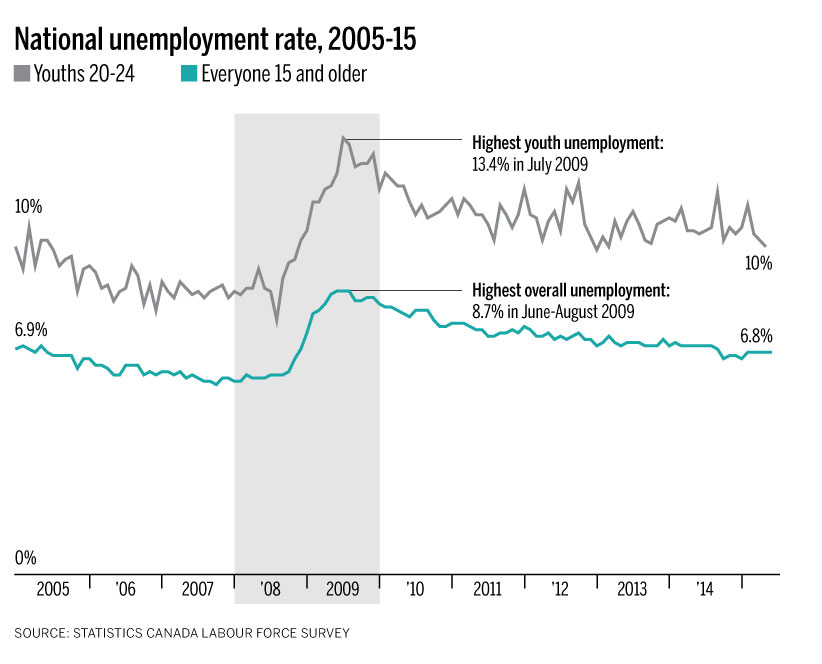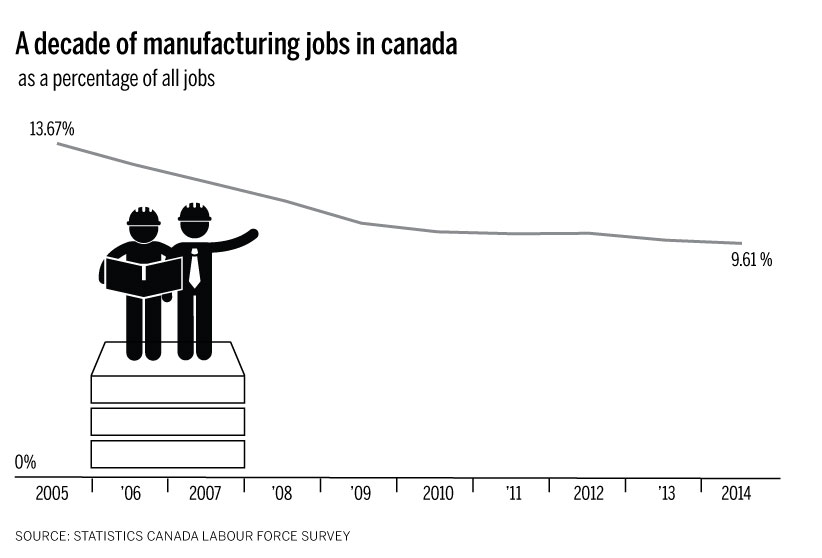Election Issues 2015: A Maclean’s primer on jobs
Maclean’s is your destination for the 2015 election. Start with our detailed primers on the big issues, including jobs
Share

When pollsters ask voters about their priorities, employment is always at or near the top of the list. The Conservatives pitch their annual budgets as plans for “jobs, growth and long-term prosperity.” Finance Minister Joe Oliver habitually framed his budget last spring as coming after the Tories created “1.2 million net new jobs” since the depths of the last recession. But the NDP points to vanishing manufacturing jobs, while Liberals stress high youth unemployment rates.
CAMPAIGNING IN A WEAKER-THAN-EXPECTED ECONOMY
Early this year, it was still possible to see a political upside for Stephen Harper in the economic outlook. Sure, Bank of Canada Governor Stephen Poloz saw the plummet in oil prices hurting Canada. But he also predicted, back in January, that the Canadian economy would, by the second half of 2015, “emerge from this much more strongly.” That hasn’t happened. In July, Poloz cut his prediction for 2015 economic growth to a dismal 1.1 per cent, down from 1.9 per cent just three months earlier. Rather than banking on a rebound, Harper now needs to campaign on the notion that his Tories are a better bet to weather hard times than either Mulcair or Trudeau.
WHERE THE PARTIES STAND
Conservative: When it comes to jobs, the Conservatives’ most consistent talking point in the House is their record on creation. Every few months, the party’s lines are updated to reflect the latest information. The last number before the House rose for the summer was 1.2 million net new jobs, a stat backed up by the number-crunchers at Statistics Canada.
NDP: They say the “1.2 million net new jobs” claim doesn’t reflect the true nature of the jobs—that is, many are short-term, precarious and unable to support families. The NDP also points to the long-term decline, since 2006, of manufacturing jobs in Canada—a number that tops 400,000. Those data are also backed up by Statistics Canada, and the NDP says the sector requires more help from Ottawa—including its proposed innovation tax credit.
Campaign pledges:
—Establish an aerospace advanced manufacturing fund
—Create jobs for 40,000 youth
Liberal: They pledge to make it easier for young people who graduate into a bleak economy to find a secure job. The party criticizes Tories for slashing youth summer employment programs, and otherwise failing to tailor policy directed at young people. They also warn that an emerging generation of young adults will end up poorer than their parents.
Campaign pledges:
—Invest $300 million over three years in the Youth Employment Strategy
Green: Their plan for job creation rests on a suite of sustainable-development pledges, wage increases and targeted tax cuts. The party would encourage clean tech and commit more early-stage financing to Canadian entrepreneurs. Greens would also create a department of tourism that would create more jobs in that sector. The party would set a $15 minimum wage for federally regulated industries, and establish a Youth Community and Environment Service Corps, which would support jobs for 160,000 young people over four years at the new minimum wage.
BY THE NUMBERS

EXPERT OPINION
“Governments always take far too much credit when the economy is doing well, and far too much blame when the economy sputters. The federal government has almost no control over day-to-day economic fluctuations, but it can create the conditions for economic growth. Parties will need to explain how they will create broad-based economic growth, given the challenges brought by automation, globalization and an aging population. Canada is almost certainly in a recession, which will take billions out of federal coffers due to declining tax revenues. Every party will need to explain how they will make up the lost funds: cut spending, raise taxes or run a deficit.”
—Mike Moffatt, economics professor at the Ivey Business School
In the short term, I think that the most important and relevant policy issue is how to counter the negative demand-side shock that has hit the economy in the form of a 50 per cent drop in the price of crude oil. According to conventional macroeconomic theory, the government might want to stabilize the economy in the form of stimulative monetary and fiscal policy. The Bank of Canada is providing the former, yet the federal government has pursued a very restrictive fiscal policy stance for years now in the form of harsh budget cuts. I would expect that the opposition parties will be sharply critical of that policy. In the long-term, whichever party wins power must address the weak investment spending that has prevailed outside of the energy sector, and the perpetually weak innovativeness that retards the growth in productivity.
—David Gray, economics professor at the University of Ottawa
ON THE 2015 CAMPAIGN TRAIL
In first promise of the official 2015 federal election campaign, Stephen Harper said the Conservatives would increase the apprenticeship job creation tax credit to $2,500 from $2,000 and expand the program to include a third and fourth year of training.
GO DEEPER
- Q&A: Stephen Poloz on jobs, household debt and the economy
- There’s something wrong with Canada’s job-market statistics
- Our nation, divided: jobs and politics

